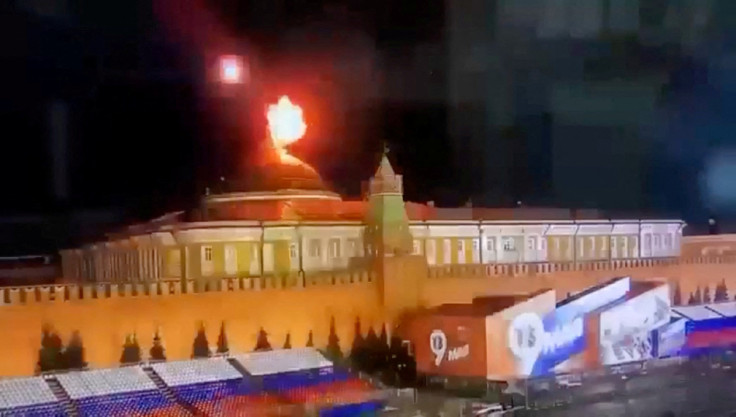Drone in alleged Putin assassination plot launched from inside Russia, claim US experts
A report from the Institute for the Study of War (ISW) has also said that "Russia likely staged this attack."

The recent drone attack on the dome of the Kremlin Senate building could have been carried out from inside Russia, US experts have claimed.
Russia had claimed that Ukraine launched drone attacks in an attempt to assassinate President Vladimir Putin. The Russian authorities claimed that two "unmanned aerial vehicles" were intercepted over the Kremlin on Wednesday evening and added that the drones were shot down before they could cause any damage.
Dana Goward, president of the non-profit Resilient Navigation and Timing Foundation, has claimed that the attack was likely launched from within Russian territory.
Goward explained how Russia uses "spoofing" to protect the Kremlin from such attacks and that the latest attacks could only be possible if the drones involved in the incident were being operated manually, per a Reuters report.
Low-priced GPS-controlled drones can be susceptible to "spoofing", i.e., manipulation of coordinates by hackers. This is basically sending fake GPS signals in order to fool another drone's GPS receivers.
Goward says that the drone used in the Kremlin "was likely not using GPS but was either manually controlled, suggesting a nearby launch, or just pointed and set upon a path, kamikaze style."
The videos of the alleged attacks that went viral on social media show smoke billowing out of the Kremlin. A video showed the moment an apparent drone exploded above the Kremlin. The drone exploded just above the building's domed roof. It also shows two people climbing on the roof holding flashlights moments before the drone exploded.
Russia later issued a statement blaming Ukraine for the attack and claiming that it was an "attempt on the President's life."
"We view these actions as a planned terrorist attack and an assassination attempt. Russia reserves the right to take countermeasures wherever and whenever it deems appropriate," read a statement from the Kremlin.
It went on to claim that the US was also involved in the attacks and said: "Undoubtedly, Such decisions, the definition of goals, the definition of means – all this is dictated to Kyiv from Washington."
KREMLIN DRONE ATTACK
— The Spectator Index (@spectatorindex) May 3, 2023
- Russia says two Ukrainian drones attacked Kremlin overnight
- Drones downed with no victims or material damage to the Kremlin
- Moscow says it was a terrorist attack and attempt on Putin's life
- Russia says it reserves right to respond when and how it… pic.twitter.com/loZA6c3Fvd
However, Ukrainian President Volodymyr Zelensky has dismissed all such allegations. In a statement issued during a news conference, he said, "We don't attack Putin or Moscow. We fight on our territory, we are defending our villages and cities. We don't have enough weapon[s] for this. That's why we don't use it anywhere [else]."
The US authorities have also denied any involvement, calling Russia's allegations "ridiculous."
"I would take anything coming out of the Kremlin with a very large shaker of salt," US Secretary of State Anthony Blinken told The Washington Post.
The Kremlin under a drone attack.
— Illia Ponomarenko 🇺🇦 (@IAPonomarenko) May 3, 2023
Something tells me that Putin’s three-days-long walk in the park to seize Kyiv is not going very well. pic.twitter.com/QiRvUPeVbM
Meanwhile, a report from the Institute for the Study of War (ISW) has also said that "Russia likely staged this attack in an attempt to bring the war home to a Russian domestic audience and set conditions for a wider societal mobilisation."
The ISW is a US-based think tank that has been tracking developments related to the Russia-Ukraine war.
Last year, Ukraine also accused Russia of using "kamikaze drones" to bomb residential areas. The drones were termed "kamikaze" or "suicide drones" because the attacks would destroy the drone once it was in the target position of the bombing. This is unlike other drones, which are flown back to their starting point after dropping the missiles.
These drones were believed to be Iranian-made and have been rebranded by Russia as Geran-2 drones. The drones pack quite an explosive charge and can "linger over targets before nosediving into them."
A young couple expecting their first child was among those killed when the drones struck a residential apartment building in the attack reported in October last year. Four other people died, while 18 others were injured and rescued from a collapsed apartment building.
© Copyright IBTimes 2024. All rights reserved.






